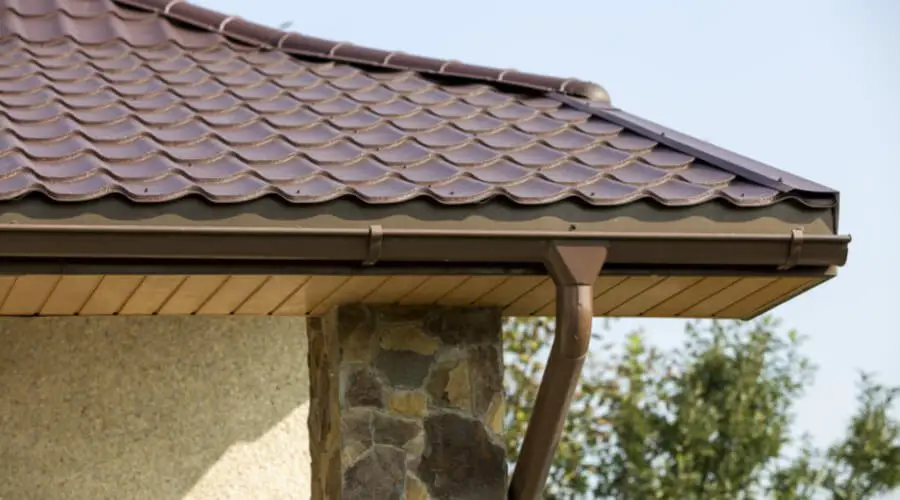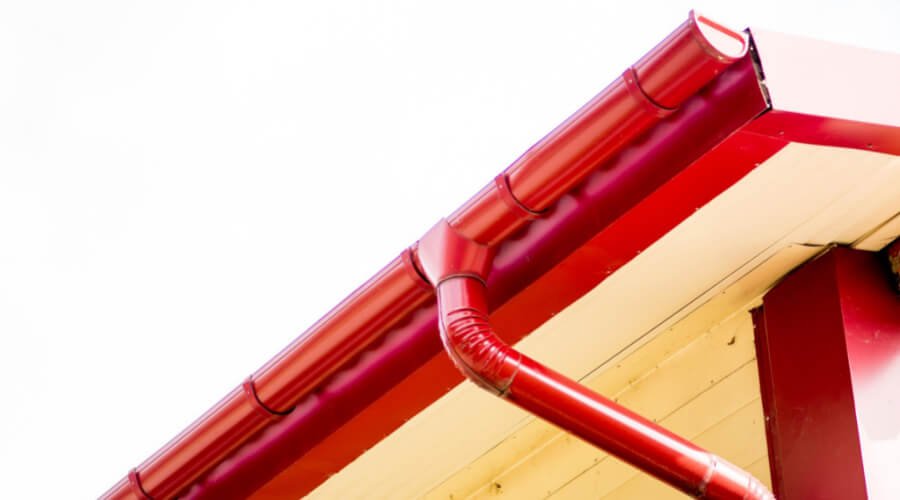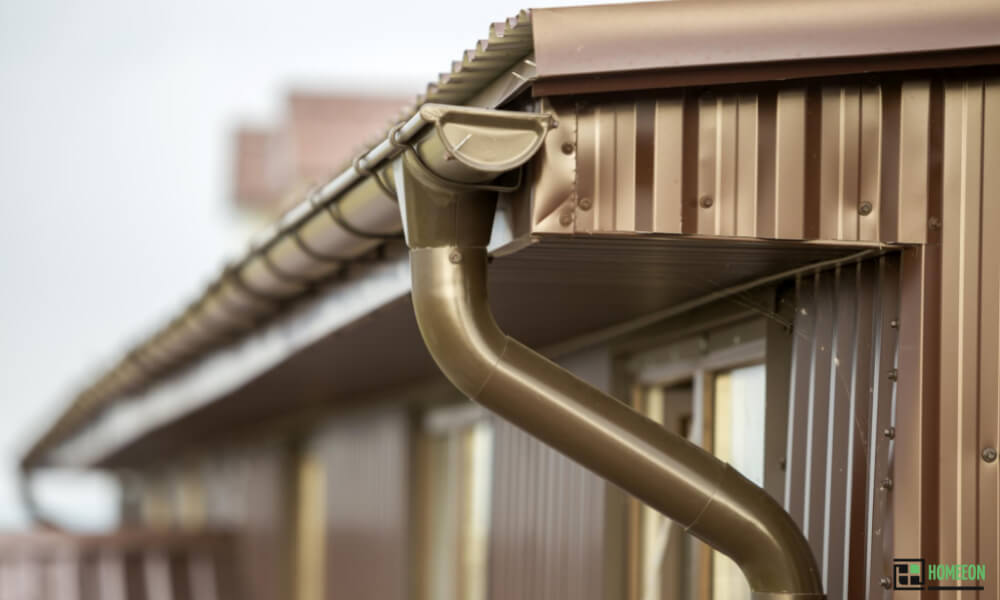Last Updated on July 31, 2023 By Emma W. Thomas
Gutters may not be necessary in arid regions with minimal rainfall, where water runoff isn’t a concern. Additionally, buildings with effective ground drainage systems, such as French drains or sloped landscapes, may not require gutters.
When Should You Avoid Gutters?

When it comes to the functionality and efficiency of a house, gutters play a crucial role in protecting its foundation, preventing erosion, and directing water away from the property. However, there are some situations where gutters might not be necessary. Let’s explore when gutters are not needed:
- Arid climates:
- In regions that experience extremely low rainfall and have arid climates, such as deserts, gutters are often deemed unnecessary.
- The limited amount of rainfall doesn’t pose a significant threat to the foundation or cause erosion, making gutters redundant in such areas.
- Flat roofs:
- Houses with flat or low-sloping roofs typically don’t require gutters.
- With proper architectural design, flat roofs can be equipped with built-in drainage systems that direct the water toward the edges and downspouts, eliminating the need for external gutters.
- Stony or sandy grounds:
- If the property has stony or sandy ground surrounding it, gutters may not be necessary.
- These types of ground surfaces allow water to permeate quickly, preventing the formation of excess water runoff that would normally necessitate gutters.
- Overhanging trees:
- Properties with significant tree cover and overhanging branches may not require gutters.
- The natural foliage acts as a natural canopy, diverting rainwater away from the house efficiently. However, keep in mind that gutters can still be useful to prevent damage to nearby walkways and landscaping.
- Properly graded landscape:
- Properties with professionally graded landscapes might not need gutters.
- Correctly sloping the land away from the foundation ensures that water drains efficiently without the need for gutters to redirect it.
- Minimal rainfall:
- In areas where rainfall is minimal or sporadic, the cost of installing gutters might not be justified.
- If the climate rarely experiences heavy downpours, the risk of damage to the foundation or landscaping due to water runoff is significantly reduced, making gutters unnecessary.
- Budget constraints:
- Gutters can be a substantial investment. If you’re on a tight budget, it may be possible to forego installing gutters initially.
- However, keep in mind that not having gutters can lead to other costly issues such as deteriorating foundations, erosion, and water damage.
Are Gutters Compulsory For Your House?
We keep asking ourselves why gutters are essential for our homes. After all, they only control an imperfect amount of water for the whole compound and create a suitable environment for nesting. Besides offering a sense of beauty to a house, gutters are essential for your house. You are likely not to experience any foundational problems with gutters fitted on roofs.
In addition, erosion will be significantly minimized around your house when it rains because of the gutters. Rainwater is likely to flow into the nearby swimming pools and stagnate in the lawns. Nonetheless, this only applies to traditional roofing. Most modern houses are not fitted with gutters, which may be confusing whether or not to use them.
Before concluding, you may consider analyzing some facts about gutters.
Facts About Gutters

- Purpose: Gutters are channels attached to the edges of roofs that collect and direct rainwater away from the building’s foundation, walls, and landscaping, preventing water damage and erosion.
- Materials: Gutters are commonly made from materials like aluminum, vinyl, steel, copper, or galvanized iron, each offering different advantages in terms of durability, cost, and appearance.
- Shapes: The most common gutter shapes are “K-style” and “half-round.” K-style gutters resemble the letter “K” from the side, while half-round gutters have a semicircular shape.
- Sizes: Gutters come in various sizes, usually measured by the width of the opening. The most common residential sizes are 5 inches and 6 inches.
- Downspouts: Downspouts are vertical pipes that carry water from the gutters down to the ground or a drainage system, preventing water from pooling on the roof or near the foundation.
- Maintenance: Regular gutter maintenance is crucial to ensure proper functioning. Cleaning debris, leaves, and dirt helps prevent clogging and water overflow.
- Gutter Guards: Gutter guards or covers can be installed to prevent debris from entering the gutters, reducing the need for frequent cleaning.
- Fascia Boards: Gutters are often attached to fascia boards, which are horizontal boards running along the roof’s edge, providing support for the gutter system.
- Importance: Well-maintained gutters protect the structural integrity of a building by preventing water from infiltrating the walls and foundation, which can lead to costly repairs.
- Local Regulations: Building codes and regulations may dictate the installation requirements and standards for gutters, so it’s essential to check local guidelines before installing or repairing them.
When Are Gutters Optional?
Occasionally, your home is multipurpose in a way that including gutters will increase construction costs yet add no value. Gutters are optional if you live on a landscape that slopes downwards as rainwater will flow away on its own.
Another instance is when you have constructed your house using concrete. Generally, concrete will offer better foundational protection, making gutters optional.
If you reside in areas that experience little rainfall, gutters are not a must. Finally, homes with extended roofs do not require gutters because water will drip at a safer distance away from the walls, sidings, and foundations.
With these situations, therefore, some roofers will still discourage gutters for valid reasons.
When Do Roofers Discourage The Use Of Gutters?
Roofing with gutters is always a good option, but always ask your roofers why they are against it.
First, gutters interfere with the facial boards. As it rains, there is a high probability that water will splash from gutters to facial boards that support the roof’s overhang. Eventually, they will rot, which raises the maintenance costs due to regular replacements.
Secondly, facial boards are easier to install and maintain than gutters. Roofers also want to avoid extra work by extending the roof instead of using gutters. Gutter clogs threaten gutters and may resist a smooth water flow, another valid reason why gutters are discouraged. Although the problem remains solvable using gutter covers, it may be expensive to get many of them when putting up a large building.
Thirdly, gutters will destroy your roof due to warping since most manufacturers use either steel or aluminum in making them. That is, they can either expand or contract so much to the extent of heaving away your roof or distorting its shape.
Finally, the cost of cleaning tools for gutters is high, making it expensive to maintain gutters. You should have the following tools: leaf blower/hose, cleaning kit, and gutter scoop when cleaning.
The acquisition of these tools is relatively expensive, excluding the time needed to perform the task. When cleaning gutters, you may also require a dust mask, goggles, and a pair of solid working gloves. Again, all these make gutter maintenance expensive, especially in optional situations.
Do You Need Gutters All Around The House?
You will not require gutters around the whole house if you don’t have slopes all around. The only desired locations will be around a slope to let water flow into a tank or wherever you have directed your pipes. Regrettably, having gutters around the entire house means many problems associated with gutters. It is, therefore, reasonable to have a few gutters to minimize handling these problems.
What Are Other Common Problems Associated With Gutters?
Sagging
Most gutters are also destroyed because of sagging. A slight dip causes water to be collected in a standard section of the gutter due to poor drainage. As the water settles for a long time, its weight lowers the gutters. Consequently, this results in hardwood failure if the gutters are attached to wood segments.
Leaking
Checking after a storm is the best time to discover and detect leakages on gutters, as they are hardly noticed on a clear sunny day. Small holes on gutters are easy to repair, but they might cost if you wait until you experience foundational erosion.
Gutter Damage
Poor maintenance makes gutters to be damaged within a short time. It could also result from sags and leakages, which are left unattended for some time. Different from other gutter-related problems, it will require the replacement of the whole gutter. Furthermore, it is a common problem for sectional gutters. Therefore, it is best to consider more factors before installing such gutters.
Benefits Of Sectional Gutters
Sectional gutters are created by connecting many gutters in distinct sections for about 20 feet. It has the following benefits:
1. Corrosion-resistant
Sectional gutters are made of smooth surfaces to allow water flow and prevent water pooling, hence minimal chances of corrosion.
2. Customization
Sectional gutters are designed in different widths of different sizes. It allows customization by mixing large and small gutter diameters at water collection and drainage points.
3. Flexibility
You can easily alter sectional gutters into different diameters and shapes like curves at the roof corners.
Disadvantages Of Sectional Gutters
1. Costly
The sectional gutter is relatively expensive, and its cost is also determined by availability. The fact that these gutters are rare to find makes them expensive, and special equipment is also required during installation to avoid sagging.
2. Open
Since they are left open, they can collect leaves and dust from the environment that might cause clogging. Gutter covers may not fit when used because of the altered shapes during installation.
Are Plastic Gutters A Better Alternative?
Current gutters are made of plastic for many reasons. Above and beyond resistance to rusting, plastics are cheap to purchase and install. Ordinarily, their prices are always half those of other gutters like aluminum- and copper-made. Their lightweight makes them easier to be lifted in bulk when installing gutters on high buildings. Metal gutters are also cumbersome when carrying up the ladder.
When you decide to use plastic, it is good to know that the sun’s rays easily dent it, and they begin to fade. They might also not be favorable in forested areas because falling branches from trees can easily break them. Plus, they generally weaken with time. Some plastics are also delicate and breakable, thus having a limited life expectancy.
Begging the question: Do other gutters have longer lifespans?
Lifespans Of Gutters
The estimated lifespan of a gutter depends on the material used to make the gutter. On average, gutters will last for 20 years, save for copper gutters with an extended lifespan of 50 years. However, proper maintenance of gutters may help improve their lifespan. You will, however, need regular inspection to determine when to replace your gutters.
No matter how durable the material is, you will reduce its life expectancy if not cleaned and checked frequently. Nonetheless, you can increase its lifespan by using gutter covers to prevent leaves and other debris from clogging the gutter. Also, position them in a slanting position for attic insulation and proper ventilation to prevent water from pooling and ice deposits.
How Do Gutters Work?
Gutters work by efficiently collecting rainwater from the roof and directing it away from the building’s foundation and walls. Here’s how the gutter system functions:
- Collection: When it rains, water falls on the roof’s surface. The sloped design of the roof allows the water to flow down to the gutters.
- Channels: Gutters, attached to the edges of the roof, form channels that run along the eaves. They collect the water as it flows down from the roof.
- Downspouts: At intervals along the gutters, there are vertical pipes called downspouts or leaders. These downspouts provide an outlet for the collected water to flow downwards.
- Diversion: The downspouts direct the water away from the building’s foundation, often extending several feet away from the base of the structure.
- Drainage: Some gutter systems are connected to underground drainage systems or rainwater harvesting tanks, further diverting the water away from the foundation.
- Prevention of Water Damage: By effectively channeling rainwater away from the roof and foundation, gutters prevent water from pooling, overflowing, or seeping into the building’s walls, which could cause structural damage, leaks, and erosion.
- Maintenance: Regular gutter maintenance, such as cleaning and inspecting for damage, is essential to ensure proper functioning and prevent clogs that can lead to water overflow.
Final Thought
Gutters are essential for your home but not compulsory. Besides the advantages and disadvantages of the material, consider the gutter’s lifespan that you select. When building a modern home, extend the roof as long as your home rests on a slope. However, you might not need gutters if you have a concrete house, your roof is extended, or if you live in areas that slope downwards or experience little rainfall.
References:
https://www.marketwatch.com/guides/home-improvement/are-gutters-necessary/
https://www.architecturaldigest.com/reviews/gutters/are-gutters-necessary
Emma is a graduate of Domestic Science or Family and Consumer Sciences (Home Economics) from the University of Wisconsin. She has 7 years of experience Working with the strategic section of BestBuy and now writing full-time for Homeeon.
From Managing the Home, Interiors, Cleaning, and Exteriors to Gardening and everything about Making A Home Liveable – is her passion and this Homeeon is the result of this.
Emma loves decorating her home with the best stuff found online. She cares about quality over anything and writes reviews about them here in Homeeon. Get in touch with her over Pinterest.
Keep reading her blogs.

